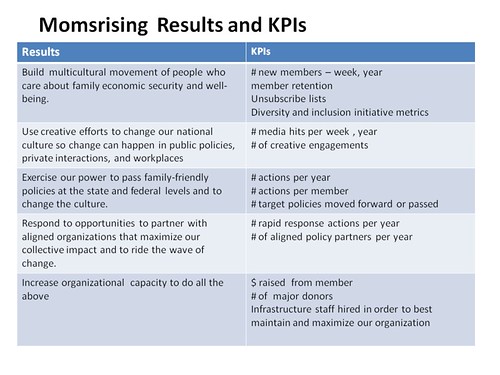
As part of my work as Visiting Scholar at the David and Lucile Packard Foundation, I’m facilitating several peer exchanges on the topics of measurement, social media, and networked nonprofits. This is feeding into my work on a book with KD Paine on that topic.
Last month I had the pleasure of facilitating another peer exchange for Packard grantees who are children’s advocates and was thrilled to have Momsrising co-founder Kristin Row-Finkbeiner share some of the secrets of how networked nonprofits approach social media measurement and practice.
MomsRising is one of the best living examples of a nonprofit born as Networked Nonprofit, a simple, agile, and transparent organization that work more like a network than a single isolated institution. Like all Networked Nonprofits, Momsrising values simplicity and the ability to leverage its network while engaging and building relationships with people and organizations to get results.
It comes as no surprise that Momsrising embraces measurement and learning. It is embedded in the way they work and their organizational culture. It has fueled their growth from zero members in May of 2006, to over a million active members—moms, dads, grandparents, aunts, and uncles—today! And, they do not count “likes” on Facebook as victory. Instead, they identify key organizational results areas and associated metrics to define successes and failures.
Their key results generally include:
• increasing the movement size by increasing membership
• garnering attention from all media through creative engagements
• getting policies passed
• working with aligned partner organizations
• increasing capacity
They know that to get results they cannot solely rely on social media tools. They use results as a guide for designing and implementing rapid responses as part of their multi-channel citizen engagement campaigns. Take for example how they responded last month to the ongoing budget negotiations, when tens of billions of dollars in cuts to Medicaid and Medicare were put on the table.
Momsrising wanted to demonstrate to Congress that there was a grassroots constituency that supported Medicaid and dispel a misperception that while Medicare has a strong constituency, Medicaid did not.
Momsrising knows from years of message testing and research, that to change minds about an issue, wonky stats fall flat. But stories resonate. They identified a rapid response goal of getting the stories dozens of moms who benefited from Medicaid and who could put out a strong defense for the program in the media.
Using a story collection landing page on their site, they urged their members to share their stories. They collected over 500 stories from 43 states about how Medicaid was helping families. They curated the best ones that illustrated their message and re-purposed these stories in to all their action alerts across channels. This generated over 100,000 letters to Congress about the debt ceiling and the importance of Medcaid.

Masters of the multi-channel approach, Momsrising’s other tactics included hand delivering “story books”, hard copy compilations of the stories to Congress and the White House. They also place these stories as letters to the editors in traditional newspapers. Notes Kristen, “Social Media channels like Twitter and Facebook are important to us because we share those stories directly with targeted members of Congress. We post specific stories on targeted legislator’s Facebook Walls or we @reply them on Twitter. We’ve found that there are less filters between us and Congress when we use social media channels. While they can easily ignore our emails and phone calls, sharing the story directly with them through social media channels – they have to respond.” Recent studies have shown that 64% of Congressional offices use social media to gauge public opinion.)
Another key result area is to bring about policy change to create a more family-friendly nation. Last month, Momsrising was invited to bring moms to the White House to talk with policy staff about their experience with Medicaid. The White House blogged about power of people’s stories.
As a follow up, these members to wrote a blog post about their experience. Says Kristen, “The after-story is just as important because it will often get picked up my a traditional media outlet like NPR or “tradigital” media outlet (blogs) such as the Huffington Post.

As a Networked Nonprofit, they understand simplicity and have not built a complex nonprofit with its own policy department. Momsrising focuses on what they do best – outreach and organizing moms – but not in isolation. Momsrising works with dozens of advocacy groups to extend their network without pulling themselves off task. Kristin said, “Our expertise is in working with our moments and powering the movement. We don’t go out on anything solo, we rely on partners for policy analysis and many other things.”

The process of setting key results and collecting key metrics to measure progress is only half the battle. It is the process using the data to make decisions and getting member feedback.
Momsrising holds a weekly staff meeting nicknamed “Metrics Monday.” Each program and campaign staff person reviews their reports in preparation for a group conversation about what actions to reinforce, how refine messages, and other improvements. Says Kristin, “Our dashboards have multiple views – a high level view and the ability to drill down into specific campaigns – this informs our discussion.”
An important part of the mix is the use of member feedback – both qualitative and surveys. “We are in dialogue with our members to figure out what works, what doesn’t. The metrics keep us focused on our mission of building a movement for family economic security, while listening and engaging with our members breathes life into our movement.” As a Networked Nonprofit, they understand the importance of learning loops when working a rapid response environment.
Momsrising also understands that learning leads to success.
- Fail: Some experiments bomb. Momrising staff gives themselves permission to kill each other’s projects or tactical ideas that were brilliant at the time but simply don’t work. They do this with humor to remove the failure stigma and call it a “Joyful Funeral” Before they bury the body, they reflect on why it didn’t work. Any staff person can call a Joyful Funeral on anyone else’s idea.
- Incremental Success Is Not A Failure: They do a lot of experiments and set realistic expectations for success. Many times victories happen in baby steps. They know from experience that many of their campaigns that incorporate social media lead to incremental successes, small wins or small improvements.
- Soaring Success: Some experiments, actions, or issues will see dramatic results – beyond the organization’s wildest dreams. For example, an interactive educational video ended up garnering over 12 million views and hundreds of comments and lead to thousands of new members signing up or taking action. Kristen says, “That type of success does not happen every day, but we need to try for that kind of success every day. We can only do it if we kill things that don’t work.” They also analyze game changing successes to make sure it can be replicated or wasn’t an accident.
What are your organization’s key results? What are the best metrics to measure those? How do you use this data to guide design and implementation of your communications strategies?
